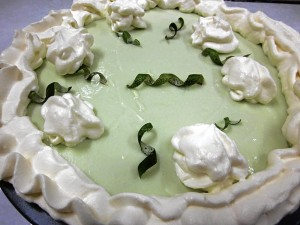
Every time I mention making calamansi pie, friends who haven’t tasted it wonder, how sour is that? Calamansi, the native baby lime, is after all not exactly sweet. And while many of us are familiar with lemon tart or lemon meringue, calamansi in a pie may still sound strange.
Yet whenever I make calamansi pie for a gathering, guests find it delicious. The pie isn’t sour at all, just pleasantly tangy. I developed the recipe for calamansi pie for a book I was writing some years ago, then adjusted it for my more recent cookbook, “The Recipes I Love” (available in National Book Store and in PowerBooks for P150 a copy). The pie is easy, yummy and really quite a novelty.
Recently, however, I experimented with dayap instead of calamansi. Dayap is also known as key lime in the US. It isn’t easy nowadays to find dayap in Manila’s supermarkets but luckily I was recently given a generous supply of it by National Scientist Benito Vergara of Asia Rice Foundation and by my aunt, Corazon Vallarta Lorenzo, who grows dayap trees in her farm in Nueva Ecija.
While the very thought of dayap may be mouth-puckering, this dayap pie isn’t sour at all. It’s just a little bit tart, but its main flavor profile is sweet. Try this dayap recipe and you’ll have a novelty dessert to serve your guests.
Dayap Pie
For the crust:
2 tbsp sugar
1 c graham cracker crumbs (around seven strips of Graham crackers, each strip having 3 crackers)
¼ c melted butter
For the filling:
¼ c water
1 tbsp gelatin powder
2 c whipping cream or all-purpose cream, well-chilled
1½ c sweetened condensed milk
½ – ¾ c freshly squeezed dayap juice (see tips)
3-4 drops green food coloring
To garnish: (optional)
Whipped cream
Zest of 1 to 2 dayap
Make the crust:
In a bowl, mix sugar, graham cracker crumbs and melted butter until smooth. Sprinkle into a nine-inch or eight-inch pie pan and press evenly on the bottom and sides of pie pan. Chill for 15-20 minutes.
Make the filling:
Pour water into a small saucepan and sprinkle gelatin on top. Let stand until gelatin granules swell. Heat over low heat for around two to three minutes, or until gelatin dissolves completely and liquid becomes clear. Set aside.
Meanwhile, beat the cream at medium speed in an electric mixer until fluffy and medium peaks form when beaters are lifted from the bowl, around four to five minutes. (Do not overbeat, otherwise the cream will liquify and will be unusable.) Gently pour in condensed milk, dayap and the prepared gelatin mixture. Continue beating at medium speed until blended, around two minutes.
Add green food coloring, drop by drop, beating well after each drop, until mixture becomes a light green, citrusy color. (For a darker shade, add a few more drops of green food coloring.) Cover bowl and chill in refrigerator for around 15-20 minutes, or until mixture starts to become solid (it should only be partially set).
Remove pie crust from refrigerator and spoon in the dayap filling, smoothing the top. Chill for four to six hours, or until firm.
To garnish (optional): Just before serving, spoon the whipped cream into a piping bag fitted with desired tip (star tip, shell tip, etc.) and pipe decorative designs of the cream around the sides of the pie. If desired, decorate with dayap zest.
For more tips, recipes and stories, visit author’s blog www.nor
machikiamco.com and facebook fan page www.facebook.com/nor
machikiamco. Follow on Twitter @NormaChikiamco
Cook’s tips
You can use either ½ cup or ¾ cup of dayap juice, depending on how tangy or tart you want the pie to be.
Be sure to use real condensed milk (not those branded condensada, which is watery).
If, after you’ve filled the crust with the dayap filling, you still have some filling left, just spoon it into a dessert cup and serve it as dayap mousse.